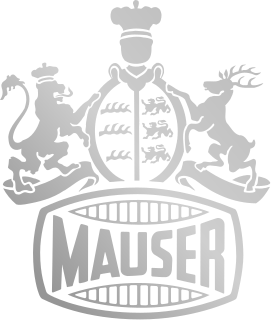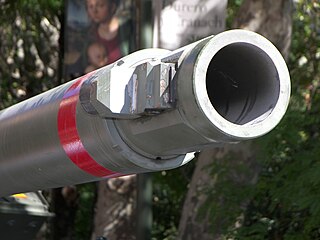Related Research Articles
The MG 34 is a German recoil-operated air-cooled machine gun, first tested in 1929, introduced in 1934, and issued to units in 1936. It introduced an entirely new concept in automatic firepower – the Einheitsmaschinengewehr – and is generally considered the world's first general-purpose machine gun (GPMG). Both the MG 34 and MG 42 were erroneously nicknamed "Spandau" by Allied troops, a carryover from the World War I nickname for the MG 08, which was produced at the Spandau Arsenal.
The MG 42 is a 7.92×57mm Mauser general-purpose machine gun designed in Nazi Germany and used extensively by the Wehrmacht and the Waffen-SS during the second half of World War II. Entering production in 1942, it was intended to supplement and replace the earlier MG 34, which was more expensive and took much longer to produce, but both weapons were produced until the end of World War II.

The Maschinengewehr 30, or MG 30 was a German-designed machine gun that saw some service with various armed forces in the 1930s. It was also modified to become the standard German aircraft gun as the MG 15 and MG 17. It is most notable as the design pattern that led to the MG 34 and MG 42, and thus is one of the major ancestors of many of the weapons in service which would later find widespread use into the 21st century.

The FG 42 is a selective-fire 7.92×57mm Mauser automatic rifle produced in Nazi Germany during World War II. The weapon was developed specifically for the use of the Fallschirmjäger airborne infantry in 1942 and was used in very limited numbers until the end of the war.

Mauser, originally Königliche Waffen Schmieden, is a German arms manufacturer. Their line of bolt-action rifles and semi-automatic pistols has been produced since the 1870s for the German armed forces. In the late 19th and early 20th centuries, Mauser designs were also exported and licensed to many countries which adopted them as military and civilian sporting firearms. The Mauser Model 98 in particular was widely adopted and copied, and is the foundation of many of today's sporting bolt action rifles.
The MG 17 was a 7.92 mm machine gun produced by Rheinmetall-Borsig for use at fixed mountings in many World War II Luftwaffe aircraft, typically as forward-firing offensive armament. The MG 17 was based on the older MG 30 light machine gun, as was its defensive flexible-mount counterpart, the MG 15 machine gun.
Rheinmetall AG has a presence in two corporate sectors with six divisions, and is headquartered in Düsseldorf, Germany. Rheinmetall AG is listed on the Frankfurt Stock Exchange; its shares are traded on all German stock exchanges. In fiscal 2019, the company generated sales of €6.255 billion. For that period the Group's Defence segment had sales of €3.522 billion, while sales of its Automotive segment were €2.736 billion.
Blowback is a system of operation for self-loading firearms that obtains energy from the motion of the cartridge case as it is pushed to the rear by expanding gas created by the ignition of the propellant charge.

The MG 131 was a German 13 mm caliber machine gun developed in 1938 by Rheinmetall-Borsig and produced from 1940 to 1945. The MG 131 was designed for use at fixed, flexible or turreted, single or twin mountings in Luftwaffe aircraft during World War II.

Sömmerda is a town near Erfurt in Thuringia, Germany, on the Unstrut river. It is the capital of the district of Sömmerda.

The MG 3 is a German general-purpose machine gun chambered for the 7.62×51mm NATO cartridge. The weapon's design is derived from the World War II era MG 42 universal machine gun that fired the 7.92×57mm Mauser round.

The Rheinmetall Rh-120 is a 120 mm smoothbore tank gun designed and produced by the West German Rheinmetall-DeTec AG company, developed in response to Soviet advances in armor technology and development of new armored threats. Production began in 1974, with the first version of the gun, known as the L/44 as it was 44 calibers long, used on the German Leopard 2 tank and soon produced under license for the American M1A1 Abrams and other tanks. The 120-millimeter (4.7 in) gun has a length of 5.28 meters (17.3 ft), and the gun system weighs approximately 3,317 kilograms (7,313 lb).

Ferdinand Ritter von Mannlicher was a German engineer and small arms designer. Along with James Paris Lee, Mannlicher was particularly noted for inventing the en-bloc clip charger-loading magazine system. Later, while making improvements to other inventors prototype designs for rotary-feed magazines, Mannlicher, together with his protégé Otto Schönauer, patented a perfected rotary magazine design, the Mannlicher–Schönauer, which was a commercial and military success.

The 5 cm Pak 38 (L/60) was a German anti-tank gun of 50 mm calibre. It was developed in 1938 by Rheinmetall-Borsig AG as a successor to the 3.7 cm Pak 36, and was in turn followed by the 7.5 cm Pak 40. Note the unique curved gun-shield design which differs from most WWII anti-tank guns which have either one flat or two angled and one flat gun-shield plates for ease of manufacturing.
Heinrich Vollmer was a German small-arms designer.

Johann Karl Friedrich August Borsig was a German businessman who founded the Borsig-Werke factory.

The MG 45 was a machine gun based on the MG 42, which was developed but not fielded in significant numbers by the German Army in World War II.

The T24 machine gun was a prototype reverse engineered copy of the German MG 42 general-purpose machine gun developed during World War II as a possible replacement for the Browning Automatic Rifle and M1919A4 for infantry squads. The T24 was chambered for the .30-06 Springfield cartridge.
The Rheinmetall MG60 is a general-purpose machine gun of West German origin. The weapon is a post-World War II derivative of the MG 45 experimental general-purpose machine gun.
The 3.7 cm Tankabwehrkanone 1918 in starrer Räderlafette or 3.7 cm TAK 1918, was an anti-tank gun built by Rheinmetall for the Imperial German Army near the end of the First World War. This was the world's first AT gun ever built that was purpose-designed for the role of an anti-tank gun.
References
- ↑ "Dead End: MG 39 Rh". Forgottenweapons.com. Archived from the original on 15 June 2013. Retrieved 19 June 2013.
- 1 2 Willbanks, James: Machine Guns: An Illustrated History of Their Impact, page 115. ABC-CLIO, 2004.
- ↑ "Dead End: MG 39 Rh". Forgottenweapons.com. Archived from the original on 15 June 2013. Retrieved 19 June 2013.